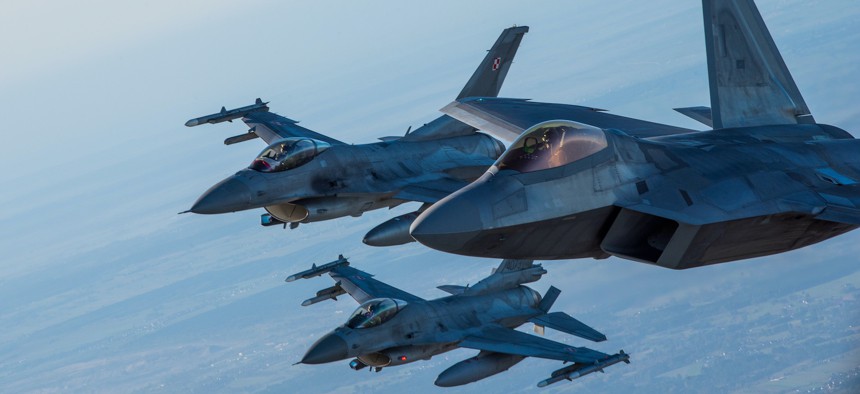
A U.S. Air Force F-22 Raptor assigned to the 90th Expeditionary Fighter Squadron flies alongside two Polish F-16s in formation during NATO Air Shielding media day, Oct. 12, 2022, at Łask Air Base, Poland. U.S. Air Force / Staff Sgt. Danielle Sukhlall
NATO Plans Record Air Exercise as Finland Joins Alliance
Air Defender 2023 exercise will include 100 U.S. aircraft, 2,000 troops, in “largest transatlantic movement” the Air National Guard has ever done.
As NATO brings Finland into the fold, the U.S. and Germany are preparing for the largest deployment of U.S. air forces to Europe since the formation of the U.S.-led security alliance.
The upcoming exercise, Air Defender 2023, will test the Air National Guard’s “ability to rapidly deploy and rapidly employ [forces],” similar to what the United States would have to do if the Ukraine war spreads to NATO, said Lt. Gen. Michael Loh, director of the Air National Guard. “It is the largest transatlantic movement we've done.”
The Air National Guard, which maintains units for “prompt mobilization during war” in addition to its role in homeland defense, will send about 100 aircraft to Germany for the 10-day exercise in June, Loh said during a press conference Tuesday. The exercise will include aircraft the U.S. is about to retire, such as A-10s and F-15Cs, as well as new aircraft, such as F-35s, upgraded F-16s, and KC-46s, Loh said.
Air Defender will be Finland’s first major NATO exercise as a member country. Chief of the German Air Force Lt. Gen. Ingo Gerhartz said Finland will send its F/A-18 Super Hornets, since it won’t begin flying F-35s “for a few years.”
“I think that they will get to learn a lot from us and then likewise, we'll be able to learn a lot from them and how they employ their F/A-18s, which will then go into turn how they're going to employ their F-35s,” Loh said.
The addition of Finland doubles NATO’s border with Russia, and Loh said the country also brings “some very, very great capabilities” to the alliance. “If you look at the size of the country, and what they have around their country, it's an agile combat employment. They have landing strips just about everywhere. And they build them right into the roads and so they have the ability to take that on.”
Officials said that the exercise was “years in the making” and was planned before Russia’s invasion of Ukraine; Gerhartz, when asked if NATO has told Russia about the exercise, said, “We don't have to send them a letter to inform them.”
The primary objective of Air Defender is to “show and prove” that the alliance is able to defend itself, Gerhartz said. “NATO is a pure defensive alliance, but if somebody attacks one country, he attacks us all.”
Germany decided to buy F-35s last year as part of the country’s move to upgrade its military forces after Russia’s invasion of Ukraine. By 2026, Gerhartz said, the country will begin training in the U.S. German pilots will fly the joint strike fighter in their country by 2027.
“This recent reinvestment in the German military has provided more opportunities to what we call ‘integrated by design,’ and that is getting common weapon systems and common platforms. That allows us then to share information on the battlefield like we never had before,” Loh said.
“Collectively, as we go into this long term, we will see that we will have better flexible defense of NATO and of Europe and ability to be fully interoperable and interchangeable on the battlefield. So it's all about deterring the adversaries so that we never have to go to war, and the ability for us to rapidly aggregate airpower,” Loh said.
In addition to Air Defender, the U.S. Air Force will conduct a large exercise this summer over the Pacific Ocean called “Mobility Guardian.”


